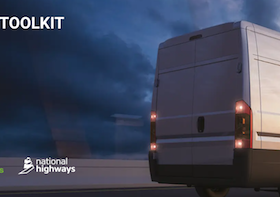Winter brings all kinds of hazards for the commercial driver. Driving for Better Business looks at you how you can prepare your drivers so that they always reach their destination safely.
 Driving for Bette Business offers these top tips to share with your drivers for safe winter driving.
Driving for Bette Business offers these top tips to share with your drivers for safe winter driving.
Driving Tips for Winter
Let’s start with the first 4 things to remind your drivers about.
- Don’t wait for winter! Falling leaves obscure hazards and markings, and they are very slippery. Autumn also brings earlier twilight, dark mornings and dazzling sun low in the sky.
- Check your vehicle carefully – daily for vans, weekly for cars. Pay particular attention to tyre treads, lights and fluids – oil, water, and windscreen cleaner. Make sure you have de-icer and scrapers on board.
- Drive smoothly. Hard acceleration, harsh braking, and sudden cornering all make skidding more likely. Allow extra anticipation and reaction time. Remember that, even if you are handling the conditions well, other road users may not.
- Drive slowly in rain, mist or fog. 13% of all serious collisions involve poor weather, and almost 80% of these involve rain. Do not under-estimate how much you must slow down if it’s raining hard – poor visibility, aquaplaning, much longer braking distances and flooding are all hazards. Don’t drive through any standing water deeper than four inches – even an eggcupful can wreck your engine and leave you stranded. If the road looks wet, yet there’s no spray from the tyres passing you, then there may be black ice. Ice in the top corners of your windscreen, and on your mirror arms can be an indicator. Finally, only 41% of roads run by local highways authorities are gritted. Local authorities are not automatically obliged to remove snow or ice from roads. Equally National Highways has extensive winter safety resources including 535 gritters – but they also have 4,300 miles of road to treat.
Winter driving – the things to look out for
Your drivers will have heard all of this before but the change of seasons is a good time to reiterate these winter driving safety rules. Here’s another tips to share with your drivers.
- Keep your distance. In poor conditions, the two second rule becomes the four second rule. Leave twice the normal space between you and the vehicle in front, and give extra room when passing vulnerable road users.
- Check the weather forecasts regularly against your route. Be flexible and choose the safest route, not necessarily the shortest.
- Have a survival pack on board. If you get stuck in snow, it could be a life saver. It should include warm clothing, waterproofs, a torch, energy bars or other long-lasting food, and bottled water. Chemical heat pads can be really useful for tucking into gloves or boots. Have a battery pack so your phone can remain charged.
- Signal early and for longer than usual. Manoeuvre smoothly.
- Watch out for high ground. In high winds, elevated positions or very open roads are particularly dangerous. If you are pulling an empty curtainsider, open the curtains before leaving – this stops the trailer acting like a huge sail. Equally in icy conditions, high ground like bridges often freeze first and may not have been gritted.
- Don’t stop on the hard shoulder unless the vehicle literally will not move. Take the first exit from a major road and find somewhere safe to park. Don’t push on to your intended stopping place if the conditions are treacherous.
- Wear your PPE. Solid waterproof boots with a good tread are important so you don’t slip as you climb down from the cab. Gloves with a strong grip are also important – freezing metal sticks to skin.
- Heed weather warnings. If the Met warns against unnecessary travel, then don’t go unless the journey is critical. Better that deliveries are late, or customers serviced late, than you put yourself and others at risk.
If you manage drivers you can check out our guides on autumn and winter driving in the Van Drivers’Toolkit, which is free to download and share.


.gif?rand=3151)









